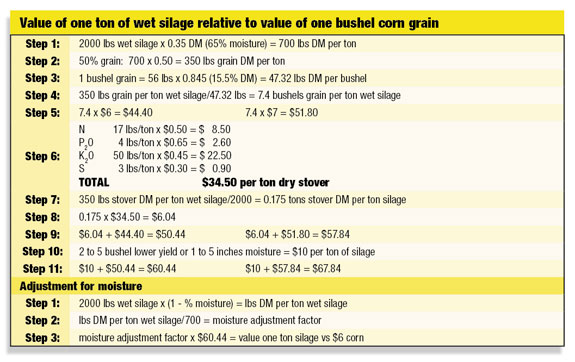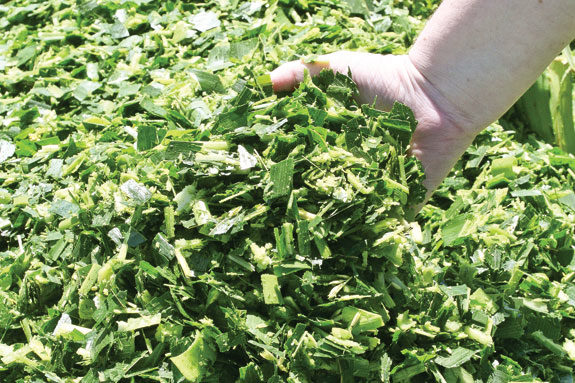Silage seems more difficult but needn’t be, especially if you are willing to use a breakeven comparison to the grain harvest option.
Corn silage tends to contain half of its dry weight as grain and half as stover. Of course, this ratio will vary depending on hybrid, growing conditions and harvest management.
For example, if soil moisture is low during grain fill so grain yield is depressed, grain will provide a lower portion to the silage dry weight.
Likewise, if grain yield is average or better and silage is chopped while leaving a taller stubble in the field to improve silage nutritional value, grain will provide a higher portion of the silage dry weight.
If corn silage is 65 percent moisture when chopped, one ton of silage contains 700 pounds of dry matter. Using the 50:50 ratio, 350 pounds will be grain and 350 pounds will be stover.
Since one bushel of #2 corn grain at 15.5 percent moisture weighs 47.32 pounds (56 pounds x 0.845 dry matter), 350 pounds of grain is almost 7.4 bushels of corn. With $6 corn, that’s $44.40 worth of corn in one ton of silage; at $7, it’s $51.80.
And that’s just for the grain. If corn grain is combined, the stover, with its minerals and organic matter, remains in the field to feed the next crop.
When silage is chopped, the stover is removed from the field. These nutrients need to be replaced.

One ton of corn stover dry matter averages 17 pounds of nitrogen, 4 pounds P2O5, 50 pounds K2O and 3 pounds S.
If the fertilizer price of these nutrients is 50, 65, 45, and 30 cents per pound, respectively, the fertilizer value of one ton of corn stover dry matter is $34.50.
Since one ton of corn silage has 350 pounds of stover dry matter (0.175 tons), the fertilizer replacement value is $6.04 per ton of silage. Adding the stover fertilizer value to the corn grain value makes one ton of corn silage worth $50.44 to $57.84 compared to harvesting the corn for grain only.
But that’s just the fertilizer value of the stover. University research suggests that corn will yield two to five bushels per acre less next year when planted into a field that previously was harvested for silage instead of as grain with no corn stalk removal.
It also may require one to five more inches of water as rain or irrigation to reach peak yield due to loss of residue cover. So lower yields or increased production costs easily could add another $10 per ton of silage.
This brings the final tally for one ton of 65 percent moisture corn silage to $60.44 to $67.84 when corn grain is $6 to $7 per bushel.
Interestingly, an old rule-of-thumb says one ton of corn silage should be worth 10 times the price of a bushel of corn, almost exactly the same as what was calculated above.
If comparing net returns from chopping silage to combining grain, don’t forget to subtract harvest costs for the silage.
Lastly, not all corn silage is harvested at 65 percent moisture. Wetter silage has less dry matter and is worth less per ton; drier silage is worth more.
To make the adjustment, calculate the pounds of dry matter in one ton of silage and divide by 700 (the pounds of dry matter in one ton of 65 percent moisture silage). Multiply this number by the value of 65 percent silage as calculated above (or by using the 10-time corn price rule). FG
Bruce Anderson
Extension Forage Specialist
University of Nebraska











